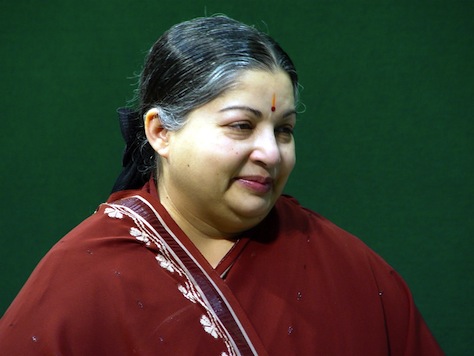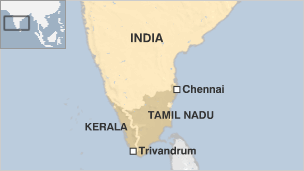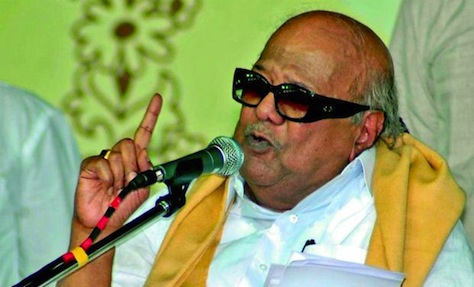As Narendra Modi looks for new places where the ‘Modi wave’ can power him to a majority government, one of those place won’t be Tamil Nadu.![]()
That’s because, like so many other states in India, Tamil Nadu is dominated by regional parties. Though the politics of Tamil Nadu are unique to the state, it’s a case study in how regional politics can influence and distort national outcomes.
With over 72.1 million people, Tamil Nadu, which sprawls along India’s southeastern coast, is one of the biggest prizes in India’s nine-phase, five-week marathon election contest, boasting 39 seats in the 545-member Lok Sabha (लोक सभा), the lower house of India’s parliament.
Tamil Nadu has the second-largest state economy in India, after Maharashtra (home to Mumbai). Chennai, its capital, is a hub for manufacturing, services and finance, and it and other state cities benefit from being part of the great IT sector hinterland that’s drawn so much foreign investment to Bangalore, which lies just to Tamil Nadu’s northwestern corner.
Though Kerala (0.790) and Delhi (0.750) lead India with the highest state/territory-level human development indices, Tamil Nadu’s HDI (0.570) is equivalent to that of Maharashtra, making it higher than the Indian average (0.467) or in Gujarat (0.527). Tamil Nadu’s GSP per-capita is also, slightly, higher than Gujarat’s. That’s significant because Modi is largely campaigning on the economic prowess of the ‘Gujarat model‘ and his economic stewardship of Gujarat since 2001.
Though Modi and the Hindu nationalist Bharatiya Janata Party (the BJP, भारतीय जनता पार्टी) are expected to win this spring’s election, it’s still an open question if he and the BJP’s allies can amass the 272 seats that they’ll need to form a secure majority government.
One of the reasons for that is the dominance of regional parties like those in some of India’s largest states, including Tamil Nadu, Uttar Pradesh, West Bengal and Odisha.
Amma’s state
That also means that the state’s chief minister and its virtual strongwoman, Jayalalithaa (pictured above), a former Tamil cinema actress, could become one of several outsiders to which Modi turns to form a coalition. If there’s anyone in India who’s perfected the personality cult, it’s Jayalalithaa, whose face greets you throughout the state, from rural towns to urban centers like Chennai (formerly Madras) and Madurai. Known affectionately as ‘Amma’ (‘mother’ in Tamil), her government is responsible for setting up ‘Amma canteens‘ to provide subsidized food to the poor, providing ‘Amma bottled water‘ to deal with chronic shortages and even establishing ‘Amma theaters‘ for entertainment purposes.
For the more prurient of you, here’s an awesome clip of Jayalalithaa pushing the sexual boundaries of Indian cinema (she was the first Tamil actress to appear in a skirt):
Critics say that the efforts are designed to boost Jayalalithaa’s popularity in advance of this month’s elections and 2016 regional elections; supporters argue that the canteens, in particular, have effectively strengthened food security throughout Tamil Nadu.
She’s so ubiquitous that a mocking Tumblr website, ‘Jayalalithaa is Watching You,’ recently sprung up for a short while, and her growing personality cult has been compared to that of former Libyan leader Muammar Gaddafi:
“She embodies three of the most important trends in Indian regional politics,” says Jessica Seddon, an American economist, based in Chennai. “She is imperial in style, technocratic in her administrative approach and … populist in her politics.”…
Yet as a chief minister she has also shepherded Tamil Nadu’s fast-growing economy, earning respect from business leaders. “Jayalalithaa has helped Tamil Nadu become India’s greatest manufacturing centre, and a home to global companies such as Ford and Hyundai,” says Gopal Srinivasan of the Chennai-based TVS conglomerate. “She is a skilled administrator and a formidable politician, and could play a larger national role. People should not underestimate her.”
As the leader of one of the two dominant regional parties, the AIADMK, she is currently serving as chief minister of Tamil Nadu for the third time. Despite her disqualification from the office over a decade ago, due to a corruption conviction, and despite the fact that some parts of Tamil Nadu are experiencing water shortage issues and power outages for up to 18 hours a day, Jayalalithaa’s AIADMK is nonetheless projected to gain more than half of the state’s 39 seats in the Lok Sabha.
Polls show that in Tamil Nadu, voters prefer Jayalalithaa over both Modi and Rahul Gandhi as the next prime minister. As it turns out, it’s not so incredibly farfetched — if the BJP and its allies fall far short of the 272 threshold, and enough third parties join together (potentially with the tacit support of Congress), a ‘third front’ government could possibly form India’s next government, headed by a prominent chief minister. Jayalalithaa, as a longtime leader of India’s sixth-most populous state, is as good a choice to head a third front government as anyone — especially if the AIADMK winds up as the largest third party in the Lok Sabha.
Jayalalithaa might also be convinced to join a BJP-led coalition, but Modi should be wary — her decision to pull the AIADMK’s support from the BJP government in 1998 led to its collapse and snap elections in 1999.
As the campaign has intensified in recent days, Jayalalithaa, despite close personal ties to Modi, has nonetheless taken a few swipes at the BJP leader:
Ending her campaign in the city on the eve of deadline for electioneering, she signed off in style by claiming, “The lady in Tamil Nadu is better than Modi in Gujarat in governance.”
Reeling out data on various parameters to buttress her stand that Tamil Nadu was ahead of Gujarat, she asked the electorate who was the better administrator, “Gujarat’s Modiyaa or Tamil Nadu’s intha ladyaa (Gujarat’s Modi or this lady)?” to a thunderous applause and asserted it was she who gave the best governance.
DMK, BJP and Congress fight over the scraps
The other major player in the fight for Tamil Nadu is the DMK (Dravida Munnetra Kazhagam, திராவிட முன்னேற்றக் கழகம், Dravidian Progress Federation), the original Dravidian party from which many of the smaller regional parties, including Jayalalithaa’s AIADMK, originally sprang. In India’s previous general election, the DMK, which then controlled the state government, won 19 seats, though it’s also projected to lose almost half of them this time around.
Its leader, the 89-year old Karunanidhi (pictured above), is also something of an institution within the state. He’s led the DMK since 1969, and he’s served five times as chief minister of Tamil Nadu — from 1969-71, 1971-76, 1989-91, 1996-2001 and most recently from 2006-11.
Excepting one 5.5-month period, either Jayalalithaa or Karunanidhi have served as Tamil Nadu’s chief minister since 1989. Just like Jayalalithaa’s government today, Karunanidhi’s most recent administration tried to use handouts, ranging from free color television to free health care for the poor, to build support.
As in just about everywhere in India, the governing Indian National Congress (Congress, भारतीय राष्ट्रीय कांग्रेस) is forecast to lose many of its seats — in Tamil Nadu, it might lose all of them. Some polls also project that the BJP will, for the first time, make some small inroads into Tamil Nadu on the strength of a seven-party coalition that brings together a handful of minor Dravidian parties.
Its coalition includes the upstart DMDK (Desiya Murpokku Dravida Kazhagam, தேசிய முற்போக்கு திராவிடக் கழகம், National Progressive Dravidian Federation), yet another regional party formed by Vijayakanth, yet another Tamil cinema actor, in 2005. It currently serves as the second-largest party in Tamil Nadu, and is the second-largest member of the governing alliance headed by Jayalalithaa’s AIADMK.
Most recently, however, it’s the DMK that’s played the more adept role in national politics — it allied with the BJP from 1999 to 2004 when Atal Bihari Vajpayee served as prime minister, and it allied with Congress in 2004 and 2009, though its split with Congress means that it will fight this year’s elections as an unaffiliated force. Though it hoped to distance itself from the anti-incumbency mood that’s currently plaguing Congress, the DMK remains sullied by some of the most treacherous scandals associated with the outgoing government.
Andimuthu Raja, a DMK minister who has served under both Vajpayee and current prime minister Manmohan Singh, served as cabinet minister for communication and information technology between 2007 and 2009. In that role, he emerged as one of the major players implicated in the 2G Spectrum scandal, whereby officials accepted billions of dollars in bribes from telecommunications companies in exchange for cut-rate deals in allocating spectrum licenses. The 2G scandal ranks among the most egregious examples of corruption in modern Indian history. Closer to home, as you might expect for someone who’s served intermittently in power since the 1960s, Karunanidhi is dogged by allegations of nepotism, with many members of his extended family becoming wealthy from positions in power or in business. A feud between his two sons has weakened the DMK’s unity and could yet cause it to split into two factions.
A short primer on Tamil Nadu’s Dravidian politics
Though they follow from a longstanding intellectual pedigree in Indian political history, the DMK and the AIADMK have for decades been personality-driven parties with little discernible ideological different in modern Tamil Nadu politics.
Unlike in some Indian states where the rise of regional parties dates to the past decade or two, Tamil Nadu’s regionalism is long-standing and dates to the era before Indian independence. Congress hasn’t controlled state government in Tamil Nadu since 1967, and the DMK and AIADMK have switched places in government for nearly half a century.
Roughly speaking, it’s possible to divide Indian languages into two groups. The Indic, or ‘Aryan’ languages of the north (e.g., Hindi/Urdu, Bengali, Punjabi, Marathi, Gujarati) have origins in the ancient Sanskrit language that has become the canonical language of Hinduism, and they’re one branch of the larger Indo-European family of languages.
The Dravidian languages of the south (e.g., Tamil, Telugu, Kannada and Malayam), on the other hand, which belong to the Dravidian family of languages, originated in South Asia and, today, don’t extend much farther than South India. The prevailing divide in Sri Lanka, the island nation just to the southeast of Tamil Nadu, is a linguistic divide — the Dravidian Tamil language dominates along the northeastern coast, while the Indic Sinhala language dominates in the central heartland and in the southwest near the capital, Colombo.
Accordingly, even before independence, south Indian political leaders hoped for an independent Dravidian state, rather than be incorporated into a larger Indian state that would ultimately become dominated by the Hindi-speaking north. The original Dravidian movement, the South Indian Liberal Federation (or the Justice Party), was devoted to countering Brahmin hegemony within south India and promoting, upon independence, a Dravidian state encompassing most of what during British colonial rule was known as the ‘Madras Presidency,’ a sprawling province that included much of south India.
Its successor, the DMK, was established in 1949 by C.N. Annadurai, and it quickly de-emphasized southern Indian independence for more pressing issues, including the economic disparity between north and south India. Annadurai and the efforts of the DMK in 1965 prevented Hindi from becoming India’s only official language by retaining English as an official language as well. The protests over Hindi led to Congress’s annihilation in the state, and Annadurai led Tamil Nadu’s first state-wide Dravidian government after winning the 1967 state elections.
Karunanidhi succeeded Annadurai upon his death in 1969, and he’s ruled the DMK as its baron ever since. M. G. Ramachandran, known as ‘MGR,’ a popular Tamil actor of the 1950s and 1960s, became increasingly involved in state politics as a DMK activist. As he rose to prominence politically, however, Karunanidhi tried to undermine him and ultimately suspended MGR from the party.
MGR responded by forming his own party in 1972, the ‘All India Anna Dravidian Progress Federation,’ or AIADMK. In league with the Congress Party and its domineering prime minister of the 1970s, Indira Gandhi, MGR ultimately became chief minister in 1977, the first time that the AIDMK won control of the state’s government.
After MGR’s death in 1987, his widow Janaki Ramachandran initially succeeded him as chief minister, but she ultimately lost a battle for control of the AIADMK to Jayalalithaa, who’s controlled the AIADMK for the past quarter-center with an even stronger grip than MGR.
The two parties, DMK and AIADMK, have traded power ever since in Tamil Nadu, with few discernible ideological differences. Mainstream Dravidian parties in Tamil Nadu long ago dispensed with the cause of independence, and as economic, developmental and social progress in India’s south ultimately eclipsed the levels in much of northern India, north-south tensions have somewhat subsided. That’s left two parties competing on the strength of populist rhetoric, personality cults and governmental handouts. Caste politics, too, play a major role, with the AIADMK embracing Brahmins and the DMK appealing to lower castes.



